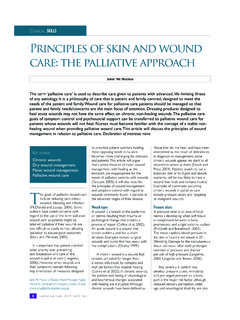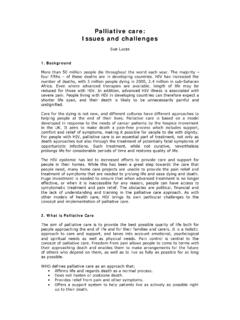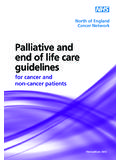Transcription of Orientation Manual – Self-Study Program for Hospice …
1 Orientation Manual Self-Study Program for Hospice Employees OVERVIEW: This Manual addresses core concepts and topics known to assist you in your work within Hospice and palliative care, especially within a rural setting. It is intended as a guide to direct you to other resources that will supplement the information provided. Each discipline will require further reading, study and information. Check with your agency to find information specific to nursing, social work, volunteer work, therapy (physical, occupational, music, etc), and for clergy. Experiential learning will be a major component of Hospice work as you attend IDT case management meetings, and through observation during site Hospice site visits. Resources and web sites are listed as the end of this document. Since web sites frequently change formats and information, we cannot be responsible for changes that occur once this document is placed on our website.
2 We are listing these as current resources. These key websites will lead you to multiple resources about Hospice and palliative care. In addition, it is strongly suggested that a library of current books on Hospice and palliative care be available to supplement the topics suggested in this Orientation Manual outline and to use as ready references. These books include: 1. American Academy of Hospice and palliative Medicine (1999). Hospice and palliative Medicine: Core Curriculum and Review Syllabus. Dubuque, Iowa: Kendall/Hunt Publishing Company 2. Andrews, M., & Boyle, J. (1999). Transcultural Concepts in Nursing Care (3rd Ed.). Phiiladephia: Lippincott 3. Ferrell, B: (2001). Textbook of palliative Nursing. Oxford University Press. 4. HPNA (1999) Hospice and palliative Nursing Practice Review (3rd Ed) Kendall Hunt Press. 5. Lipson, J., Dibble, S., Minarik,P.
3 (1996). Culture & Nursing Care: A Pocket Guide. UCSF School of Nursing Press. 6. McCaffery, M & Pasero, C. (1999). Pain Clinical Manual (2nd ED). St. Louis: Mosby. 7. Sheehan, D & Forman, W. (1996). Hospice and palliative Care: Concepts and Practice. Boston: Jones and Bartlett Publishers. 8. Twycross, R. (1997). Introducing palliative Care (3rd Ed.). Oxon, UK: Radcliffe Medical Press Ltd. 9. Weissman, D & Biernat, K. (1999). Communication Teaching Modules for the End-of-Life Educator. Milwaukee, Wisconsin: Medical College of Wisconsin. 10. Weissman, D. & Ambuel, B. (1999). Improving End-of- Life Care: A Resource Guide for Physician Education. (2nd Ed). Milwaukee, Wisconsin: Medical College of Wisconsin. There are numerous journals that will have up-to-date research and information about palliative care and Hospice . GOAL To assist Rural New Mexico Hospice staff in training and education of new personnel in similar and consistent methods across rural New Mexico sites.
4 Each family and situation is unique. OBJECTIVES Upon completion of using this Manual the Hospice professional will have be introduced to the key components and topics for working within Hospice and palliative care. The Hospice professional will have access to resources that can supplement and enhance your work experience and study of Hospice and palliative care in rural areas. SESSION OUTLINE I. Welcome and Introduction II. Overview of Orientation Process III. Mission of Your Agency IV. Introduction to Hospice / palliative Medicine a. Philosophy b. History c. Standards of Care V. Concepts of Hospice / palliative Care a. Physical b. Psychological c. Spiritual (Body, Mind and Spirit) VI. Role of Team Members in Hospice / palliative Medicine a. Medical Director b. Patient Physician c. RN d. Social Worker e. Pastoral Care f.
5 Certified Nurse Assistant (CAN) g. Family Member h. Community Member VII. Introduction to Communication Issues of Hospice / palliative Medicine VIII. Specific Communication Skills IX. The Healer Must be Healed - Importance of self -Care X. Exploring Personal Views XI. Dealing with Stress XII. Cultural Issues Related to Hospice / palliative Care XIII. Assessment of Pain Role of Team Members XIV. Pain Management XV. Pain as the Fifth Vital Sign XVI. Symptom Management XVII. Psychosocial Issues XVIII. Spirituality Issues XIX. Grief and Bereavement XX. Ethical and Legal Issues XXI. Individual Disciplines XXII. Helping People Understand the Health Care System Related to Hospice / palliative Care XXIII. Continuing Education XXIV. Resources ACTIVITIES Reading Interactive participation Discussion with agency staff Interactive participation/website Hospice INTERDISCIPLINARY COMPETENCIES: Competencies considered important to work in Hospice and palliative care include.
6 Be able to articulate Hospice philosophy, goals and objectives with emphasis on the meaning of palliative care and the meaning of quality of life Demonstrate an understanding of your organization s communication system, means of personal support and continuing education processes Articulate basic ethical principles and your agencies approach to decision making from an organizational and clinical perspective Explain the Interdisciplinary Team (IDT) Case Management Process Outline the process of patient/family referral and admission Demonstrate an understanding of Hospice and palliative nursing care Demonstrate an understanding of spiritual care within Hospice and palliative care Demonstrate an understanding psychosocial care Discuss grief and bereavement issues related to Hospice and palliative care Discuss the importance of accepting diversity in Hospice and palliative care Discuss the importance and utilization of Hospice volunteers Demonstrate appropriate death attendance and closure skills Articulate and demonstrate an understanding of providing and documenting patient care across settings.
7 Including reimbursement and regulatory issues Discuss the utilization and referral procedure for ancillary services Discuss the role of Hospice in community outreach efforts and services Articulate the key components of communication in Hospice and palliative care Articulate and practice self -care activities I. Welcome and Introduction 1. Thank you for joining our Hospice team. You may have years of experience with Hospice settings and Hospice care or you may be new to working with a Hospice team. We are glad you are here. My experience is that people who come to work in Hospice are caring, compassionate, loving and empathic individuals. Your purpose is ultimately to help this team help others, not to cure, but to heal. We will talk about the real meaning of healing later in this process. There is basic information for everyone to know and there are many areas of specific information for specific team members, such as the RNs, social workers, and therapists.
8 Since we do work out of a team concept, knowing the role of each team member can keep the process running smoothly. Although some team members may be responsible for exact information, each team member has a responsibility to have a general understanding of Hospice / palliative care concept and the potential needs of patient and family. 2. Introduce yourself to all team members. (Have each individual tell why they have chosen to work in Hospice and a BRIEF story about their association with someone in pain or with the dying process.) II. Overview of Orientation Process 1. Review the sections of the Manual and topics to be covered. 2. Review the section on Resources - this will be important to supplement information in the Manual . III. Mission Statement Review the Mission Statement for your agency and for the National Hospice / palliative Care Association.
9 See: National Hospice and palliative Care Organization 1. Review Goals and Objectives for your agency IV. Background and History of Hospice / palliative Medicine Resources: American Academy of Hospice and palliative Medicine (1999). Hospice and palliative Medicine: Core Curriculum and Review Syllabus. Dubuque, Iowa: Kendall/Hunt Publishing Company Weissman, D & Biernat, K. (1999). Communication Teaching Modules for the End-of-Life Educator. Milwaukee, Wisconsin: Medical College of Wisconsin. 1. Background and History of Hospice Versus palliative Care 2. Review history of Hospice 3. Philosophy of Hospice and palliative care defined by World Health Organization (WHO). palliative Care = the active total care of patients whose diseases are not responsive too curative treatment life-limiting illnesses. Hospice care generally provided during the latter segments of the continuum of care for patients with life-limiting illnesses.
10 4. Hospices in rural takes place where people live and work. Hospice agencies in rural areas often have limited access to medications and personnel. See statistics on: Click on Stats/Research/Resources V. Concepts of Hospice / palliative Care Resources: American Academy of Hospice and palliative Medicine (1999). Hospice and palliative Medicine: Core Curriculum and Review Syllabus. Dubuque, Iowa: Kendall/Hunt Publishing Company Ferrell, B: (2001). Textbook of palliative Nursing. Oxford University Press. 1. Individual aspects of Hospice / palliative care include several components as a wholistic approach. Review each component. a) Physical b) Psychosocial c) Spiritual d) Standards of Care e) Barriers to Hospice / palliative Care VI. Role of Team Members in Hospice / palliative Care Resources: American Academy of Hospice and palliative Medicine (1999).






